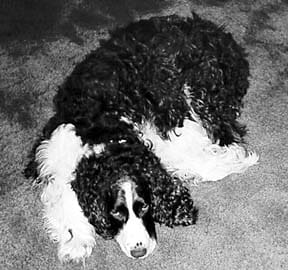For Star, an eight-year-old Springer Spaniel cross, life hasn’t always been easy. But thanks to treatments by Pedro Rivera, DVM, of The Healing Oasis Veterinary Hospital in Stutevant, Wisconsin, Star’s life glimmers again. In addition to traditional veterinary medicine, Dr. Rivera often treats his animal clients with chiropractic, homeopathic and Chinese remedies, and glandular therapy.
Star’s life wasn’t always plagued with illness. As a puppy and young dog, he seemed to be a picture of health: high energy, a good appetite, and a great disposition. Star’s owner, Janet Stone, had adopted him when he was just three months old, and he enjoyed good health until he was five and a half years old.
One fateful Saturday afternoon, after Star declined his regular meal, Stone began watching him. He felt hot and grew more and more listless. The next day, he grew increasingly lethargic, and that evening, had a seizure. Stone rushed him to the emergency animal clinic nearest their home.

The veterinarians on call saw that Star was jaundiced; his kidneys and liver were failing for unknown reasons. They administered antibiotics and fluids intravenously, hoping to stabilize his condition. Stone and her husband were disappointed to hear that unfortunately, the fluids and antibiotics represented all that traditional veterinary had to offer for Star’s condition, and the doctors there proffered little hope.
Star’s regular veterinarian, however, was Dr. Rivera, who had a much bigger toolbox.
“I first heard about Dr. Rivera and his wife from my sister-in-law, who had taken a dog to him,” says Stone. “She told me that he was a good doctor, but that he used really different methods and medicines than traditional doctors – he didn’t believe in pumping a dog full of pills and shots. My husband and I liked the approach, and the first time we ever took Star there, we were so impressed. We used his clinic for all of Star’s routine health care, and we were always happy with him.”
Since it didn’t seem as though there was anything else traditional veterinary medicine could do for him, the Stones felt Star would be better off in Rivera’s care, since Dr. Rivera had both conventional and alternative tools at his disposal.
A Multi-Faceted Veterinarian Exam
Upon assessing the troubled dog, Rivera found Star’s liver to be enlarged and his liver enzyme levels drastically high, about 300 percent of their normal levels. The basic function of the liver is to detoxify the body, and if this system fails, the toxins “back up” in the body (not unlike a backed-up sewer system), causing the animal to take on a yellow tint in its eyes, gums, and skin. this condition, in both animals and humans, is known as jaundice, and it can be life-threatening if not resolved. Dr. Rivera also determined that due to Star’s kidney and liver failure, his body was attempting to utilize nutrients stored in his muscle tissue, resulting in a condition known as “muscle wasting.”
His examination went beyond the Western medical tests, however. Rivera’s initial inquiry also includes mental and emotional evaluations of the animal. He queries owners about their dogs’ behavior patterns, questions like, “Does the animal like to be alone?” and “Does the animal have any specific cravings?” The answers to such questions can be telling, Rivera says. If an animal is displaying signs of extreme lethargy, for example, he then asks the owner about their own feelings.
“Many times, the fears of the owner affect the animal,” Rivera explains. In Star’s case, Rivera felt the owner’s fear that Star was going to die was contributing to his rapid decline.
Non-Traditional Healing Methods for Dogs
Rivera suggested a multi-pronged treatment approach which combined a homeopathic remedy, a Chinese herbal tea, and glandular therapy. Ideally, just one approach is used to attain a successful outcome, but given Star’s poor condition, Rivera felt a combination of treatments was necessary.
The strongest weapon in the fight to save Star’s life was a Chinese herbal tea which was custom-formulated for Star by Rivera. One of the main ingredients in the teas was AiYe (English name: Capillaris), often used to treat cancer patients. Stone admits that this treatment made her a bit apprehensive at first.
“I’d never considered this type of treatment before,” she said, “I thought, ‘A tea is going to save my dog?’ But I was willing to try anything, and I had total faith in Dr. Rivera.” Stone made the tea, and administered it three times daily to a weary Star. Within a day and a half, Star began showing slight improvements.
“It was remarkable. His appetite slowly improved, and by day three, he wagged his little tail,” Stone said.
Rivera also initiated a treatment of Arsenicum Album (Arsen. Alb; Arsenious Oxide), a homeopathic remedy. Homeopathy involves finding a “constitutional remedy” that treats the entire body. Unlike Western medicine where a patient’s symptoms are treated, homeopathy treats the body as a whole. By giving a particular homeopathic remedy – in this case, the Arsenicum Album – Star’s physical problems were addressed, along with his mental, emotional and spiritual well-being.
Rivera also gave Star special supplements to help rebalance out-of-whack glandular system. He put Star on Beta-TCP, which helps bile-producing cells to stabilize, and administered Cytozyme LV, which is a neonatal extract used to help strengthen the liver.
Finally, as Star improved, Rivera also overhauled Star’s diet. He recommended that the dog eat an all-natural, low-protein, high-carbohydrate regime, with plenty of foods like chicken and rice.
Within two and a half weeks, Star’s liver enzymes elevated by about 15 percent, and there was a significant increase in the dog’s appetite. Within six weeks, Star’s jaundice had completely disappeared, and his liver enzymes had returned to normal. At that point, they stopped AiYe treatments, began weaning Star off of the Beta-TCP and went to a half-dose of the Cytozyme LV.
After approximately two months, Rivera prescribed dandelion extract, which works as a diuretic and helps to detoxify and further strengthen the liver. The extract was given a few times as a tonic, and has since been discontinued. Rivera’s final diagnosis was autoimmune hemolytic anemia, an affliction in which the body destroys its own blood.
Now, two years later, Star is his old self again. His owner is grateful for Rivera’s tireless efforts on behalf of her dog. “We really owe our thanks to Dr. Rivera,” Stone says. “He really worked hard,” she says. Significantly, she notes that one of the best parts of the whole experience was the fact that Rivera offered hope for Star’s drastic condition.
“It just goes to show that there is a place for the complementary therapies – they blend well with Western medicine,” comments Rivera. He stresses, however, that this approach is much more individualized than the Western approach. “We don’t give every patient with similar symptoms the same treatments,” he says. “You have to work with a very experienced practitioner, who knows how to detect the unique needs on each individual. But just because an animals is chronically or even critically ill, doesn’t mean there is no hope.”
Alice Greany is a freelance writer from Chico, CA.





